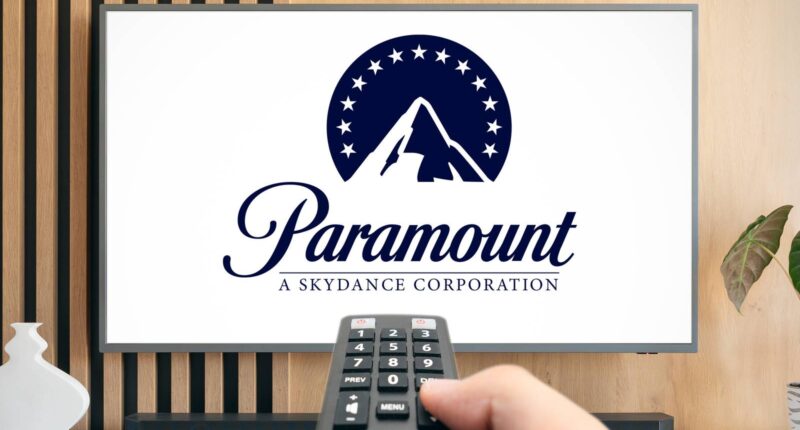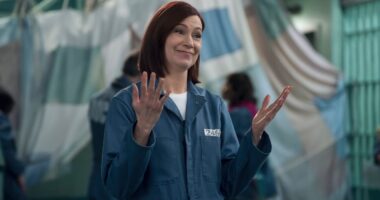When it comes to the history of television, we typically think of the “Big Three” TV networks as being the oldest and longest-running channels on the airwaves. ABC, CBS, and NBC all started in the early 20th century, first as radio networks before expanding to television — and all still exist today. But there was a fourth network that could be picked up on television sets during the late 1940s and into the ’50s — and no, it’s not Fox. We’re talking about the DuMont Television Network, and unlike its contemporaries, it had no history of radio programming to fall back on. Beat down by government regulations and a major film studio, DuMont went under after only nine years on the air.
The DuMont Television Network Began in the Mid-1940s
If you’ve heard the DuMont name before, it’s probably in reference to the long-gone TV channel. According to TV historians Tim Brooks and Earl Marsh in their book The Complete Directory to Prime Time Network and Cable TV Shows, 1946-Present, the DuMont Network was the product of its parent company, DuMont Laboratories, which was founded in 1931 by Dr. Allen B. DuMont. DuMont Laboratories was already a premiere manufacturer and purveyor of television sets and other TV-related equipment, so moving from the vehicle of storytelling to actual storytelling itself wasn’t too big of a stretch for DuMont. In the postwar era, technological innovation and the rise of at-home entertainment meant that the demand was high for new stories to be told. “[DuMont] received a commercial license in 1944 for WABD, New York (now WNYW-TV on channel five), serving as the cornerstone of that company’s ill-fated network venture,” Brooks and Marsh reported, and it wasn’t long before things expanded nationwide.
In his book, The Forgotten Network: DuMont and the Birth of American Television, historian David Weinstein dates the DuMont Network’s official debut to April 15, 1946, as DuMont himself aimed to move the project “out of the experimental era” with Manhattan and Washington, D.C.-based studios at the helm. With that, DuMont became the “first commercial television network,” connecting the East Coast at a time when that seemed impossible. Yet, according to the Museum of Broadcast Communications, NBC and CBS weren’t far behind. Although DuMont began the network TV craze, producing weekly programming content several nights per week, the other two networks had radio talent and programs to pull inspiration from. Furthermore, because their radio stations were already established, the other two networks were able to use their affiliates to secure television licensing from the Federal Communications Commission (FCC), something DuMont would struggle to do.
Although DuMont Laboratories was the main financial backer behind the DuMont Network, Paramount Studios had also been involved with the parent company after the film studio purchased shares in DuMont several years prior. But Paramount had its own ambitions for television, soon opening up stations of its own in both Los Angeles and Chicago — stations it was unable (and unwilling) to share with DuMont. And this is where things get a little complicated. As DuMont aimed to expand its reach, hoping to secure new television station licenses in Pittsburgh, Cleveland, and Cincinnati (and only succeeding with the former), Weinstein notes that “the FCC did not allow any company to own more than five station licenses.” Even if Paramount didn’t have its own motives (it would launch its own short-lived Paramount Television Network in 1948), DuMont — and the rest of the budding TV networks — had to secure strong relationships with affiliate stations in order to broadcast their programming. This led to even more intense competition.
DuMont Struggled To Keep Up With NBC and CBS
Because it was the FCC’s job to regulate commercial airwaves and then assign those frequencies, the government got to make the rules. But those rules didn’t always favor DuMont. “A network’s survival depended on a strong affiliate line-up, since broadcasters had no means of distributing their programs from city to city without these affiliates,” Weinstein explained. “However, most cities were allocated fewer than four stations [total] by the FCC.” This was not ideal for DuMont since NBC, CBS, and eventually ABC all had radio affiliates they already had business relationships with, giving them an edge over the “indie” network. DuMont may have been the first to the punch, but that was only the first step in a larger process.
DuMont owned three stations in New York (WABD), Washington (WTTG), and Pittsburgh (WDTV), but that meant very little if the network couldn’t distribute its programming nationwide via affiliates. “NBC, CBS, and ABC each obtained their quota of five stations early in the game,” Marsh and Brooks reported. “But because of a series of complicated legal rulings involving its relationship with Paramount Pictures (which also owned stations), DuMont could not, and thus was denied both the revenues and guaranteed program clearances that a full roster of five big-market stations could provide.” With the FCC allowing only three stations in certain cities, DuMont didn’t have the foothold that its competitors did. In 1949, there were barely 50 stations in operation across all the continental United States, and so the scramble to secure them became evident.
While the network could get select programs to air with those affiliates, they often chose the best or most popular — which often correlated to what was also popular on the radio. So, what programs did DuMont offer? Cavalcade of Stars — which later moved to CBS under its more popular title, The Jackie Gleason Show — was a popular variety show that aired the initial comedy sketches that became the original CBS sitcom The Honeymooners. Both Flash Gordon and Captain Video and His Video Rangers were popular half-hour sci-fi adventure shows that aired on the network (humorously, The Honeymooner‘s Ed Norton famously loved Captain Video), as did the religious devotional program Life is Worth Living, which featured Catholic Bishop Fulton J. Sheen as he spoke about the moral issues of the day. There was also The Gallery of Madame Liu-Tsong, the first TV show with an Asian American lead, and The Hazel Scott Show, one of the first to be hosted by a woman of African ancestry. And that’s not including the very first network TV sitcom, Mary Kay and Johnny, and the first soap opera, Faraway Hill, which first aired on DuMont in the mid-to-late ’40s. Boxing and wrestling were also popular on the network. But despite the decent original line-up, it just wasn’t enough.
After 9 Years on Air, Paramount Saw DuMont Shut Down After Axing an ABC Merger
By the early 1950s, the DuMont Network was available on approximately 8.5 million television sets nationwide, which was over 40% of the total American homes with televisions at the time. The network had managed to grab a foothold on the airwaves through just over 200 affiliate stations and was delivering Captain Video, Cavalcade of Stars, and a whole host of other original programming — though not Mary Kay and Johnny, which moved to NBC in 1948 before originally ending in 1950. According to a 1995 article in The Journal of Popular Culture, the network had a full evening schedule by 1948, and after spending $50,000 on advertising, Allen DuMont had hopes to see his network break even. Nevertheless, Weisman has postulated in The Forgotten Network that, between DuMont’s government contracts, manufacturing business, and the network itself, the company was spread too thin — and unable to keep up with NBC and CBS. But DuMont wasn’t the only network unsure of its own survival.
With color television on the rise (and DuMont Laboratories needing the capital to get there), the company was in a bind financially. It didn’t help that its affiliate stations couldn’t rival the other networks (hence the rise in advertising), and losing programs like Mary Kay and Johnny and eventually Cavalcade of Stars (which became The Jackie Gleason Show on CBS) probably didn’t help either. But ABC was also struggling to keep up with CBS and NBC, with reportedly less capital and resources than even DuMont at the time. ABC and DuMont were often forced to share affiliate stations, which wasn’t exactly ideal. Then, a new opportunity presented itself. “The only reason ABC survived was that they had been in the radio business, and they got [United Paramount Theaters’] backing,” explained former DuMont ad salesman Art Elliot, per The Forgotten Network. According to the Museum of Broadcast Communications, UPT (which itself was a former subsidiary of Paramount before being broken up by antitrust legislation) merged with ABC in 1953. This eventually opened the doors to partnerships with Disney and Warner Bros. to air their respective material on the network. However, just like the FCC beforehand, Paramount would not do DuMont any such favors.
Instead, the film studio made life difficult for DuMont. According to former DuMont managing director Ted Bergmann in his book (with Ira Skutch), The DuMont Television Network: What Happened?: A Significant Episode in the History of Broadcasting, Paramount stopped a potential merger with ABC — which would’ve combined their networks as ABC-DuMont — to ensure that the two couldn’t coexist. Paramount already had an axe to grind against UPT, and they seemingly had no interest in saving DuMont, either. After already limiting the network to three stations and stealing away potential affiliates through its own television arm, Paramount joined forces with other minority shareholders to force the DuMont Network and DuMont Laboratories apart in 1955. In doing so, they wrestled control of the network away from Allen DuMont himself. Despite the network’s efforts to regain capital by selling its WDTV Pittsburgh station in 1954, Paramount succeeded in dashing DuMont to pieces.
The DuMont Legacy After the DuMont Television Network
Why did Paramount care so much about destroying the DuMont Network? In their book, Bergmann and Skutch theorize that Paramount had concerns about television ruining the motion picture business. “It seemed they took every opportunity to thwart its progress,” Bergmann lamented. While there are a few conflicting reports on the exact date of DuMont’s end, everyone agrees that 1956 was the network’s final year — and that Paramount was largely responsible.
In the world of network television, DuMont was a cautionary tale as the only major broadcast television network to fail. As for what happened to the bulk of DuMont’s programming, well, it’s something of a mystery. Most episodes of Captain Video and Flash Gordon and Cavalcade of Stars have been lost to time. In fact, most of DuMont’s material was intentionally destroyed. When testifying before the Library of Congress in 1996, actress Edie Adams (who had worked at DuMont back in the ’50s and later guest starred on I Love Lucy) revealed that at some point in the 1970s, one of the companies that succeeded DuMont and took custody of its library (presumably Metromedia) had allowed copyright on much of the programming to lapse. Unwilling to store the tapes in a climate-controlled environment, one of the company’s legal reps dumped the contents in New York City’s East River. While some of the material was salvaged, much of DuMont’s library was lost forever. Talk about a watery grave.












